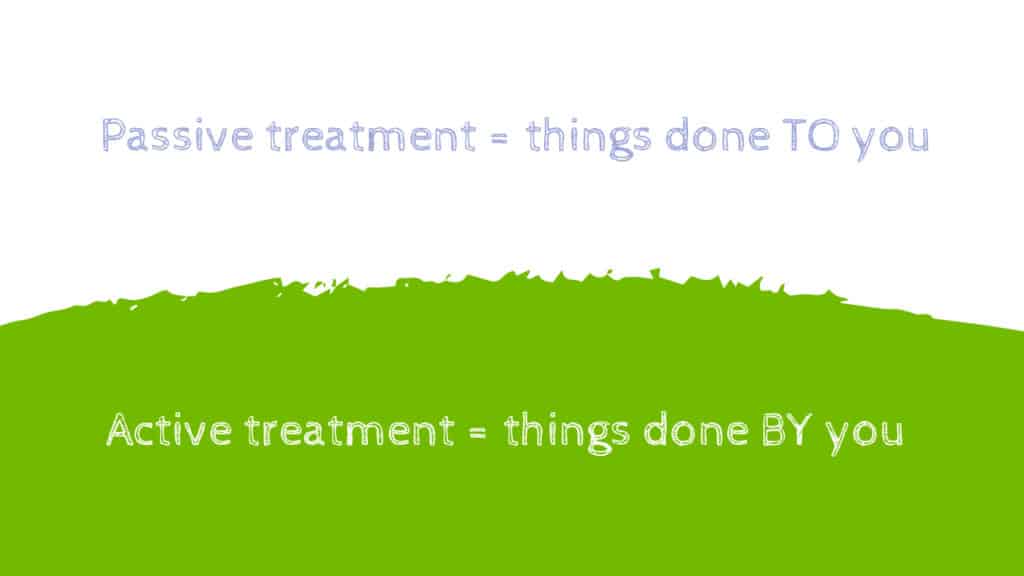You’ve got lower back pain. It could be acute back pain for the first time. Or maybe you’ve had it for years, and just haven’t found a way to solve it.
You’ve tried all kinds of manual therapy and all the exercises on YouTube.
However, it’s just not getting better. Maybe it’s time to get some help?
But there’s a problem … there are so many choices!
So how do you know if the person you choose to help you is operating with real current, up-to-date information? Or is their treatment strategy still from the 1990s? (And believe me, there are many physios that are still treating from the 1990s playbook!)
It is nearly impossible to know unless you are a physiotherapist yourself.
We completely understand that dilemma, and we want to help make it easier to judge the treatment and advice that you get.
Here is the way that back pain physiotherapy specialists operate in 2024.
Firstly, there are non-negotiable items with any treatment with any health professional …
The 4 key questions you need answered about your back pain
The best physios will give you the answer to these four questions at the end of your first consultation. Whether written down or delivered verbally, you need the answers to:
- What is wrong
- How long it is likely to take to get better
- What they can do to help
- What you can do to help yourself
Expect that your diagnosis and prognosis might be further refined over time.
However, this is the information that everyone wants to know if they have back pain (or any pain!)
You can read more about the importance of these four questions here.
Frequency of physiotherapy treatment for your back pain
If your physiotherapist is following these 4 key questions, they will provide a written plan (or at the very least a clear verbal plan), which will include their thoughts on the need for any future treatment and the frequency of these sessions.
There has been a trend for many years in certain health care industries for a relatively high frequency of treatment and creating a sense of reliance on the therapist.
In 2024, with what we know about best practice for back pain, we know that this is not in the patient’s best interest.
If we are following best practices, creating a sense of self-efficacy is important.
There are situations where seeing a patient frequently is the right thing to do, but this is going to be a very temporary situation.
Any recommendations for treatment should be governed by one thing only – what the best thing is for the patient, in consultation with the patient.
To read more about this topic, check out this blog on recommendations, and this article on the Lancet articles from 2017 that addressed therapist reliance vs self-efficacy.
This is an interesting article on how two-thirds of physios follow recommended guidelines (ie one third don’t) but that is still better than medicine.
Here is something on how physios should determine their recommendations for treatment.
So what should back pain physiotherapy specialist treatment look like?
It is really important that the person that you see has a modern understanding of back pain.
There are some non-negotiables for back pain treatment at any time, now and in the past:
- A thorough subjective and physical examination
- Screening for potentially dangerous problems or ‘red flag’ conditions
- Answering the above 4 questions
- Recommendations for treatment that are based solely on the best thing for the patient
Best treatment of back pain in 2024 incorporates a number of things:
- Less reliance on passive treatments ie things being done TO you
- More active treatments ie things being done BY you
- Making self-management a priority when at all possible, also known as self-efficacy
- Being less focussed on the question of which structure is ‘at fault’
- A biopsychosocial approach also known as a ‘whole person approach’ where the person is considered as a whole rather than just the isolated biology of their back pain
- Being a team with the patient, making decisions together and basically being on the same page. This is often called therapeutic alliance
- Using evidence based treatments and following current treatment recommendations

A new back pain treatment paradigm
Professor Lorimer Moseley is a clinical neuroscientist and pain specialist who presented a new way of delivering treatment for lower back pain in 2022 during the MasterSessions course which he called the ‘Fit For Purpose’ model.
I predict this will become the framework for treating back pain and other painful problems.
It consists of 3 parts or ‘pillars’ to treatment. Even though they are separated out, they all blend and work with each other.
The 3 pillars to the ‘Fit For Purpose’ model are:
- Understanding that your back is fit for purpose: this is the educational part. It’s all about helping the back pain sufferer to understand that even when your back hurts it doesn’t mean that your back is proportionately damaged. It is understanding that your back is still ‘fit for purpose’.
- Proving your back is fit for purpose: this is the experiential part. It’s about putting it into practice using graded exposure to exercise and loads, and proving to yourself that your back is capable, that it is ‘fit for purpose’
- Improving your brain map of your back: this part is about novel ways to freshen up, sharpen up and optimise the representation of your back and its movements.
He presented the science behind this model, and the RESOLVE trial using this model was published in 2022. This compared the Fit For Purpose model with a sham procedure and attention control. The results were vey encouraging, with significantly improved pain intensity at 18 weeks.
On the other end of the spectrum …
Here’s a big ‘ol red flag!
Electrotherapy Is so 1995
Electrotherapy does not have a role in the modern treatment of low back pain.
Whether interferential, medium frequency, ultrasound, shortwave diathermy, laser – a therapist with any credibility will not be using them in 2024.
Though each of them can have a short term effect of heat or pain modulation, there is nothing in the literature that would support the use of this kind of ‘passive’ and low value treatment.
Alarm bells should be ringing in your head about the treatment strategy, if your physio is proposing electrotherapy for your back pain. It should make you question if they are keeping up with current physio knowledge.
Treatment session length - you need enough time
It is impossible to provide treatment according to the best current practices in 15 or 20 minute appointment times that have been standard practice in the past.
I’ve tried – it doesn’t work, and just leads to frustration and less than optimal results.
Talking to patients, creating a partnership with them, educating and tackling challenging topics simply isn’t possible in short appointment times.
Having said that, it isn’t just about the length of sessions, it is also the content of the sessions too.
Ten minutes on electrotherapy is just as effective as 30 minutes on electrotherapy (if you get what I mean!)
The best physios that get the best results have initial consultations that are generous in length to allow the time to discuss, examine, explain and determine a plan with the patient.
The right language is super Important
The words that your physio uses to talk about your back pain is actually really important. More important than anyone has really appreciated in the past.
Your health professional holds such an important position in shaping your understanding of your problem.
The person you see will determine whether you have reasonable expectations about your problem, which is really important.
The words that they use can make the difference between whether you will move or be afraid of moving.
Even a simple phrase like ‘chronic pain’ has a stigma attached to it which makes it worth avoiding.
Your physio can be reassuring and encouraging or they can create fear and uncertainty.
Guess which one is better?
It’s not about being unrealistic, it’s about taking away negative and harmful terminology and creating realistic expectations and reasonable goals.
If you have a physio (or GP, chiro, osteopath, surgeon) that says something like:
- ’Whatever you do, don’t bend over or you’ll blow a disc!’
- ’Don’t bend backwards’
- ’Your back is stuffed’
- ‘It’s worn out in there’
- ’Don’t lift more than a certain weight or you’ll damage yourself’
- ‘You have chronic pain, you just have to live with it’
… or the killer statement
- ‘You’ll end up in a wheelchair’
you need to be wary,
Words really do matter.
Read this blog to learn more about why they matter. The examples will blow your mind!
And that leads nicely into…
Specialist physiotherapists talk less about individual back structures
The best physios in 2024 will be less focussed on a ‘pathoanatomical’ explanation for what is causing your pain in your back.
This is a hard one for most people to negotiate, because if you have a pain, you expect you should be able to identify an exact structure that is responsible. Often people are told it’s a lumbar spine structure like a lumbar spine disc, a facet joint, a sprain, a nerve, a ligament or a muscle.
Truthfully, that is really guess work to point the blame at one spinal structure.
The exception is where there is a distinct pattern of weakness, sensation loss and reflex loss that is consistent with a specific nerve root impingement. In this case you CAN say it is related to an anatomical structure ie a particular nerve root, but even then it isn’t all that it involved in the back pain experience.
The correct diagnosis is often ‘non-specific low back pain’. Understandably, this is a really unsatisfying diagnosis, even if it’s correct!
Even with the help of imaging, it is often impossible to say or to prove that there is one ‘thing’ responsible. The modern physio of 2024 knows that.
You can read more about the trap of the pathoanatomical approach here. It doesn’t work with persistent lower back pain (or any persistent pain).
Imaging and investigations - where do they fit in?
The best physios understand that imaging can lay a trap for the unprepared.
A really useful adage is ‘you treat a patient, you don’t treat an XRay’.
That’s because imaging can show a lot of incidental findings that aren’t relevant to the current problem.
The best physios don’t ignore imaging, but see it for what it is.
It is a tool, an extra layer of information. It doesn’t replace clinical examination and it doesn’t replace the description that their patient provides.
Imaging can be a very important tool to rule out serious problems (so-called red flag conditions) or situations that might need a change of management strategy.
The best physios understand that common findings like disc bulges, changes in disc height, facet joint changes and even conditions like spondylolisthesis aren’t automatically relevant and an explanation for someone’s pain.
They know that in low back pain, the rate of individuals with changes such as these but with NO PAIN are abundant.
You can read more information about the use of imaging in low back pain here.
The unrivalled power of directional preference for back pain
The idea of looking for a directional preference is a valuable tool for assessing low back pain.
Instead of guessing about a structure that is ‘causing’ the pain, or making decisions based only on imaging, repeated movement testing allows the physio to learn about the behaviour of the back pain and whether it is likely to respond to ‘mechanical’ treatment or not.
If you have a directional preference, it is an indication of a good prognosis. It gives your physio a whole lot of information to help you help yourself.
This is the basis of the McKenzie Method or the McKenzie Approach.
You can read more about the McKenzie Method here.
A directional preference provides prognosis information, treatment information and self-treatment options.
This is a quick quiz about whether the McKenzie Method might be helpful for your low back pain.
What about the core?
Physios have radically changed their approach to rehabilitation programs.
Instead of exercise programs being ALL about ‘the core’ and not much else, exercise and strengthening has a much more ‘functional’ approach.
There is a bit of a hangover in gyms and sports where there is still a lot of talk and focus on ‘the core’.
With the ‘core strengthening’ trend of the early 2000s, there was a lot of specific muscle retraining being done to certain muscles.
It was ‘transversus abdominis’ and ‘mulitifidus’ all the time. ALL THE TIME!
These days, strengthening is a lot more ‘functional’, meaning that it involves more general movement and weights.
These same deep lumbar muscles still get a workout, but not in the same super-focussed and micromanaged approach as before.
The Ultimate Guide To Low Back Pain Myths
There is A LOT of misinformation about low back pain, what causes it and how to get better.
This guide was created to answer our top ten myths that we hear every day.
We feel strongly that each of these myths has the potential to stop improvement.
On the other hand, there is a lot of good news when you understand the truth behind these myths.
You should feel much more optimistic about your back pain after reading this!What is the best exercise approach for low back pain?
Pilates is still a very good platform for working on strength, but there is more emphasis on movement out of the ‘neutral position’ which was the safe and happy place for a lot of physios and patients.
Graded movement and graded exercise is key for anyone with back pain. For people that have pain on bending or a fear of bending, it is important to gradually introduce it in a safe and graduated way in their physiotherapy treatment.
If someone has a directional preference (as explained above), it is used to guide the initial exercises that are given. At this stage, exercise is used as a direct treatment for pain and to regain lost spinal range of movement.
If a particular movement is found to be a focus initially, the reintroduction of the opposite movement and all directions is crucial to make sure the patient isn’t apprehensive about movement in the future.
For example, even if someone initially responds really well to extension (the opposite of bending forward), there is a time when bending needs to be reintroduced. This is determined by the patient and the physio in response to their repeated movement testing.
Exercise is a vital part of helping someone with low back pain to get their best result and to return to full function.
It is also an important tool in reducing their fear or uncertainty about doing certain movements or tasks.
These can’t be addressed effectively with passive treatments.
The role of general exercise can’t be overemphasised either. Whether walking, swimming, cycling or running, some form of general cardiovascular exercise is important for many reasons.
These include weight management, blood pressure control, which helps the following …
Reduce low level inflammation - reduce pain
There is more and more evidence emerging to suggest that low level systemic inflammation has an important role to play in increasing sensitivity levels, maintaining persistent pain and the onset of osteoarthritis.
Another important player in low-level inflammation is the gut microbiome.
You might be thinking ‘hang on – you’re a physio aren’t you?’
Yes, but this kind of information crosses the traditional boundaries as we find out how intertwined conditions like osteoarthritis are with diet, movement and cartilage loading.
You can help reduce systemic low level inflammation with dietary improvements and regular exercise.
Read more here about what constitutes an anti-inflammatory diet.
This is something that the modern physio in 2024 understands and talks about with their patients when looking at resolving a painful episode of back pain and preventing recurrence.
Dry needling - is it vital for treatment of lower back pain?
With dry needling being such a hot topic in physiotherapy, it is an important to discuss this treatment option.
Dry needling certainly isn’t a prerequisite skill for managing low back pain successfully. It can give temporary pain modulation, but it’s not the only way to achieve that. It can be achieved in many ways.
Dry needling is a completely passive therapy, so it is a treatment strategy which is not a long term. The literature bears that out.
When used best, dry needling is a short term treatment that can be useful as one aspect of helping acute pain.
Having said that, back pain can certainly be managed effectively without dry needling.
Summary - How back pain physiotherapists work in 2024
It is worth saying that not everyone needs to receive back pain physiotherapy specialist treatment.
But if you are experiencing back pain and have seen a physio (or any other health professional) for your low back pain, how did your treatment tally with each of these points?
- How have they tackled the topic of what is wrong?
- Have they given you a clear plan of attack or has the plan been on the fly and just booking next week? And on and on without a plan or goals?
- Do they lean on electrotherapy?
- Are the appointment times too short to really talk?
- Are you satisfied with the explanations that you are given?
- If there is hands on treatment, is there also good education and exercise?
- Have you been given clear patient self-management strategies?
By reading this article, you are now you are better equipped to identify if your physio follows current best practices.
And after all, the goal is to save yourself time and money (now and in the future) and to reduce your reliance on others for treatment.
To learn more about the best practices of physiotherapists in the treatment of low back pain, read The Ultimate Guide To Low Back Pain Physio In 2024.
And to help your decision if you decide to see a physiotherapist, here is a link to an informative article that will help you to know what to look for in a physio that will suit you. And what to avoid!
Organise A FREE Physio Phone Consult
Get some FREE ADVICE, find out if physiotherapy can help your problem and give you pain relief, and importantly, find out if we are the right physios for you!
Alternatively, you can organise a free 15 minute assessment in person at the clinic.
To Organise a Phone Call with a Physio
- Option one: Click on the ‘Online Bookings’ button at the top of the page, then choose the ‘Free Physio Phone Consult’ option and find a time that suits you.
-
Option two: Call us on
8356 1000 and organise a time for a call back from one of our physios for a discussion with you about your problem.

















